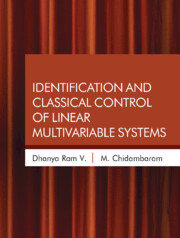Book contents
- Frontmatter
- Contents
- Preface
- Acknowledgements
- List of Abbreviations
- Notations
- 1 Models, Control Theory, and Examples
- 2 Identification and Control of SISO Systems
- 3 Introduction to Linear Multivariable Systems
- 4 CRC Method for Identifying TITO Systems
- 5 CRC Method for Identifying SISO Systems by CSOPTD Models
- 6 CRC Method for Identifying TITO Systems by CSOPTD Models
- 7 Identification of StableMIMO System by Optimization Method
- 8 Identification of Centralized ControlledMultivariable Systems
- 9 Identification of Multivariable SOPTD Models by Optimization Method
- 10 Identification of Unstable TITO Systems by Optimization Technique
- 11 Centralized PI Controllers Based on Steady State Gain Matrix
- 12 SSGM Identification and Control of Unstable Multivariable Systems
- 13 Control of Stable Non-square MIMO Systems
- 14 Control of Unstable Non-square Systems
- 15 Trends in Control ofMultivariable Systems
- Appendix A Identification of Unstable Second Order Transfer Function Model with a Zero by Optimization Method
- Appendix B For Chapter 3
- Appendix C For Chapter 7
- Bibliography
- Index
6 - CRC Method for Identifying TITO Systems by CSOPTD Models
Published online by Cambridge University Press: 31 July 2022
- Frontmatter
- Contents
- Preface
- Acknowledgements
- List of Abbreviations
- Notations
- 1 Models, Control Theory, and Examples
- 2 Identification and Control of SISO Systems
- 3 Introduction to Linear Multivariable Systems
- 4 CRC Method for Identifying TITO Systems
- 5 CRC Method for Identifying SISO Systems by CSOPTD Models
- 6 CRC Method for Identifying TITO Systems by CSOPTD Models
- 7 Identification of StableMIMO System by Optimization Method
- 8 Identification of Centralized ControlledMultivariable Systems
- 9 Identification of Multivariable SOPTD Models by Optimization Method
- 10 Identification of Unstable TITO Systems by Optimization Technique
- 11 Centralized PI Controllers Based on Steady State Gain Matrix
- 12 SSGM Identification and Control of Unstable Multivariable Systems
- 13 Control of Stable Non-square MIMO Systems
- 14 Control of Unstable Non-square Systems
- 15 Trends in Control ofMultivariable Systems
- Appendix A Identification of Unstable Second Order Transfer Function Model with a Zero by Optimization Method
- Appendix B For Chapter 3
- Appendix C For Chapter 7
- Bibliography
- Index
Summary
The method suggested in the previous chapter for the identification of Multi Input Multi Output (MIMO) First Order Plus Time Delay (FOPTD) transfer function is extended to identify Critically Damped Second Order Plus Time Delay (CSOPTD) model parameters of higher order MIMO system. The closed loop transfer function is identified as a third order system. The normalized step response curve given by Clark (2005) is used to identify the main responses of the closed loop system as a third order transfer function model. From this model, the open loop model is identified by the Closed Loop Reaction Curve (CRC) method.
Identification of Multivariable Systems
A step input is given to the yr1 and the closed loop main response yc11 is obtained. The closed loop step response is assumed to be of third order of the form in Eq. (6.1).
For a step input, the transfer function will be of the form given in Eq. (6.2).
The normalized time τ is given by Eq. (6.3). Final steady state value is given in Eq. (6.5).
The shapes of the closed loop main responses are comparedwith the normalized curves given for the third order systems by Clark (2005) where the quadratic term has a damping ratio (ζ) and the most matched curve is selected. A plot is shown in Fig. 6.1. The values of the damping ratio (ζ) and β are noted. The value of ωn can be obtained from the normalized time τ given by Eq. (6.3). The value of the pole P is obtained from Eq. (6.4). The value of K is obtained from Eq. (6.5). Thus, the closed loop main responses are identified.
The interaction responses yc21 and yc12 are identified using the Yuwana and Seborg (1982) method since the method given by Clark (2005) does not have normalized plots for responses whose final steady state is 0. The closed loop interaction responses yc21 and yc12 are assumed of the form given in Eq. (6.6). To identify ζ and τe, Yuwana and Seborg (1982) method is used. The value of K is obtained from the Laplace inverse of Eq. (6.6) as shown in Fig. 6.1.
The equation for the transfer function of a closed loop response is given byMelo and Friedly (1992) as in equations Eq. (6.7) to Eq. (6.11).
- Type
- Chapter
- Information
- Publisher: Cambridge University PressPrint publication year: 2023



